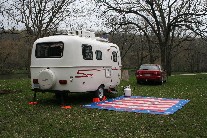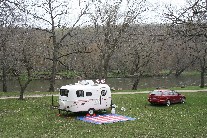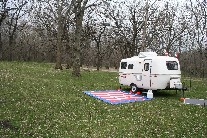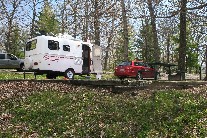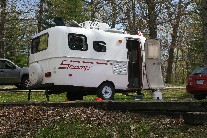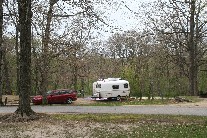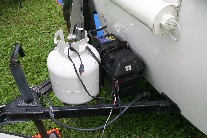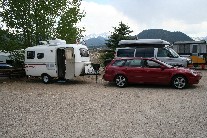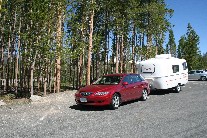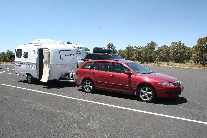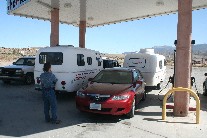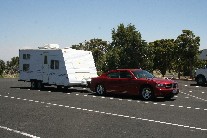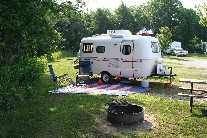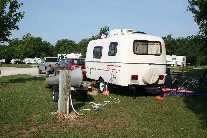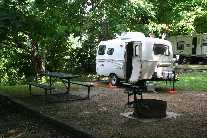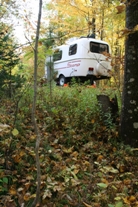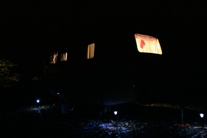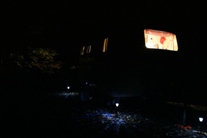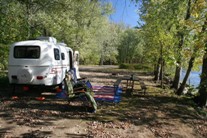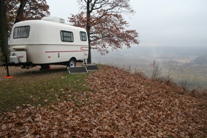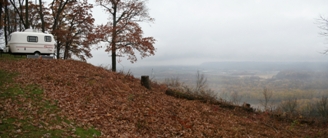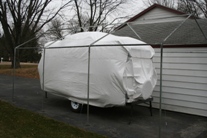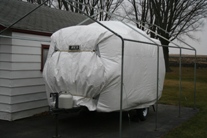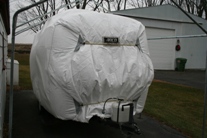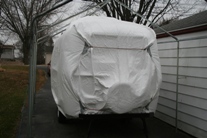Scamp Photo Album 2011
(Click Thumbnails for Larger Picture)
|
After fives months in winter storage, it was time to get the Scamp out for the first
outing of the year. This was the weekend of April 1st. Despite a
forecast that was a little questionable, we traveled up to Pilot Knob State Park
in Iowa. We had sixty plus degree weather the first day and seventy degree
the second. It felt good to take a nap in the warm sun. Although it
was warm, I elected not to de-winterize it for this trip. We managed by
taking a cooler full of water and washing the dishes when we got home. I
didn't realize how much a simple sink would be missed over a couple of days.
|
(Click Thumbnails for Larger Picture)
|
It took us a few weeks, and a snow storm, but we finally made it out for our second
trip the weekend of April 29th. Although the grass looks green and the
tress are beginning to bud out, it was still cool and windy. It reached
around 34 degrees Saturday night, but the heater worked well. Also, a tip
about the battery and electrical system. Make sure that the power
converter is plugged into 110 voltage when you are storing the trailer so the
battery can charge. Also, check your battery and clean the terminals at
the beginning of every camping season. It doesn't hurt to check the
connections every so often as well.
|
(Click Thumbnails for Larger Picture)
|
Our third weekend out was to Pikes Peak State Park in MacGregor, Iowa. We like
this campground because of the view, the location, and the comfort.
Campsites are not too close together, and they are nicely leveled off for tent,
RV, or trailer camping. The nice thing about coming this time of the
year, when the trees are not fully in bloom, is that you can see much more of
the area.
I would like to point out the orange pads and chocks you see in the pictures.
These are interlocking devices used to help level and secure the trailer.
I purchased the chocks last year because they are designed to lock into the pads
and prevent them from slipping. We also use them beneath the legs of
the trailer to help prevent them from sinking into the ground.
|
(Click Thumbnails for Larger Picture)

|

|
|
We spent Memorial Day weekend back along the Shell Rock River, our favorite place to camp. One
thing I have touched on before, but never really gone into detail is how we manage to
camp in sites without electricity. The Scamp uses an onboard marine
battery for powering everything except for the refrigerator and the air
conditioning unit. When we use sites that do not have plug ins, we use
propane to cool the refrigerator and do not use the air conditioning.
While this may work for a few days, there are times we camp for up to a week
when we are not plugged in.
To help reduce the drain on the battery, I purchased two solar panels and connected
them to the battery via a charge protection unit. The first two
pictures above show the two panels, and the third is where the battery is
situated on the trailer's tongue. The fourth picture is of the panels connection
to the charge protection unit. Both panels connect to the input, then the
output wires go to the terminals on the battery. I do not use the same
terminals on the battery for power input as I do for power output. I want to make sure
that the power being generated by the panels goes directly to the battery to
charge it, instead of being taken directly into the trailer's power system.
In the last picture, you will see the glowing red light on the charge protection
unit. This indicates that the power is going to the battery. If the
panels manage to charge the battery fully, then the power is cut to prevent over
charging.
On a good sunny day, with direct power to both panels, I can get nearly 2.5 amps of charge to the
battery. But as the light diminishes, that amount of charge decreases.
I have completely charged the battery only once, using the solar panels, but that was in direct sunlight on a nearly
cloudless day. Normally, I won't get a complete charge of the battery;
however, the solar charging system does reduce the amount of drain on the battery and extends the life of the charge.
There are a couple of things you want to keep in mind about this system. To get
the best charging results, you need to make sure the panels are pointed at the sun
at all times. I usually have to re-adjust the position of the panels every
few hours. Also, since I do store the panels in the trailer when not in
use, it is best to use quick connect plugs to connect the panels to the charge
protection unit. It will ensure a good and secure connection every time.
If you have any questions about this design, or would like to know more about it, please feel
free to contact me at Information@dampenedenthusiasts.com.
|
Summer Trip Out West
Our first major trip this year was out west to Colorado, Utah, and Arizona. We spent a week
traveling to Rocky Mountain National Park, Arches National Park, Grand Canyon,
and Mesa Verde National Park. This was the first time our Mazda pulled the
trailer through such extremes as long distance, elevation, and arid desert
conditions. I was really impressed with it's capabilities. All
totaled we went from 1,300 feet to 12,000 feet in elevation, and drove nearly
3,500 miles round trip. Gas mileage ranged anywhere from 13 mpg to 18 mpg,
depending on the wind direction. The surprising part was that it seemed to
get better mileage going through the Rocky Mountains than it did on the plains.
Just a note if you are considering using a trailer in mountainous regions,
seriously consider getting electric brake for the trailer. It was really
nice to be able to adjust the brake pressure from the car as we traveled through
the mountains. Below are the pictures of the Scamp at the various
campgrounds.
(Click Thumbnails for Larger Picture)
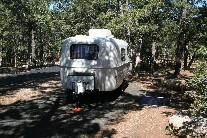
|

|
|
The first picture in this series is at the KOA in Estes Park, CO. This campground sits at the
foot of Rocky Mountain National Park. It was also the first place that I was able to use the City Water hookup on our Scamp, and I have to
admit that it was really a nice amenity. The second picture is at the KOA
in Moab, UT, and I was really impressed that they also had near full hookup for
trailers and RVs. I believe there were other sites that did have complete
hookups, but most sites seemed to have at least both electric and water. The third and
fourth was at Mather Campground in Grand Canyon National Park. We didn't
have any hookups, but I didn't really miss them. One thing I do like about
this particular park is that they have a tram system that allows you to explore
the park without having to drive. The last picture is from Mesa Verde
National Park in Colorado. I was really surprised to see complete hookups,
including sewer. Unfortunately, my gray water tank hose did not reach.
So instead, I used the sewer hookup the last day and drained the tank before
leaving. It saved us a trip to the campground's dump station.
|
(Click Thumbnails for Larger Picture)
|
Yes, that really is snow in the background in June. We drove from the KOA in Estes Park, CO to the
Alpine Visitors' Center in Rock Mountain National Park. Elevation was
12,000 feet and the car pulled it really well over the winding roads. Even
in the thinner atmosphere, it didn't seem to have many difficulties. The
last picture is at the visitors' center at the gate just outside the park.
On the way out of the mountains, I learned that increasing the brake pressure on the trailer brakes and using
them as the primary slowing force really worked well to control the whole rig on
the way down.
|
(Click Thumbnails for Larger Picture)
|
The one features I really enjoy with the trailer is the ability to pull over anywhere
and use the trailer for getting a quick nap in, or, like in the pictures above,
grabbing a bite to eat.
|
(Click Thumbnails for Larger Picture)
|
Of course, when you travel, you never know what you may run into. I was
inside, paying for the gas, and when I came back out, another Scamp had shown up
next to ours. That is the closest ours has been to another Scamp since it
left the factory lot.
When we travel, we like to take notice of what other campers have come up with to
make their trips a little easier. So I can honestly say I was surprised to
see someone pulling a larger camper with a four door sedan. However, with
the price of fuel, I can't blame anyone for trying to trim the cost of a trip.
|
Fourth of July
(Click Thumbnails for Larger Picture)

|
|
July 4th plans changed at the last minute this year, due to the
Minnesota Government shutdown, but thankfully, we were able to find another
location for camping. We were able to find a spot in one of the county
campgrounds in Howard County, Iowa. It was a nice campground that also
allowed us to make use of our newest edition to our recreation equipment, the
canoe. In trips past, I always barrowed this particular canoe and trailer
setup, but we had acquired ownership of it the week prior and were anxious to
get out on the water.
Again, the design and function of the Scamp played a pivotal role to a successful trip this year.
We were not as fortunate enough to have good shade, but the gloss white paint of
the camper helped to reflect the sun's rays, and the air conditioning unit
managed to keep the trailer very comfortable, even with near ninety degree
weather outside. Also, this was the forth time that we were able to use
the City Water hookup on the trailer. I would encourage you to keep a hose
on hand in the trailer just encase you find that you have an opportunity to
utilize that feature. The last thing I would like to mention is the
grey water disposal. While we have a tank to catch the gray water (waste
water from sinks and showers, but not toilets), if you do not have one, I would
encourage you to get a portable one for your trailer. There are an
increasing number of parks that are not allowing you to dump gray water along
the edge of your site any more. Portable tanks are becoming more of a
necessity and can be found with most RV supplies in the stores.
|
(Click Thumbnails for Larger Picture)
|
We decided to head back to Pikes Peak in MacGregor, Iowa again over the weekend of July 22nd. What I
would like to point out in the photos above is the advantage of using a smaller
camper. In the first photo you will see the two campsites. The one
on the right, where we were camped, was a much more difficult site to back a
trailer into. There are two trees on either side at the entrance to the
site, and a third a bit father back. Larger camping units would find it
very difficult to get a trailer backed into the site, especially if you arrive
after dark. With smaller trailers, you have far more room for maneuvering
and even if you make an error in backing up, they are much more forgiving and
you can correct rather easily. This site was the second time I backed into
it after dark and that third tree did not only give the trailer difficulty, but
I had be very aware of it even after the trailer cleared it.
|
(Click Thumbnails for Larger Picture)
|
This series is of the campsite we had while on our fall camping trip to northern
Wisconsin. We stayed at Copper Falls State Park, and we got here
just at the right time of year. When we arrived, most everything was still
green, by the time we left a week later, fall had truly taken hold.
|
(Click Thumbnails for Larger Picture)
|
This was still at Copper Falls State Park in Wisconsin, but it was another attempt at
night shots of the Scamp. The first one was taken as the last lights of
day faded away, and it was almost completely dark. I am really happy with
the way the ground lights came out, and the glossy reflection off of the Scamp.
The last two were taken well after dark and I thought I would try one more time.
I love the ground lights in both pictures and I am really happy with the way the
light reflects off of the bushes behind the trailer. The last shot shows
that better.
|
(Click Thumbnails for Larger Picture)
|
We finally got to Merrick State Park in Wisconsin the weekend of October 14th.
The sites we usually reserve had not been reservable for most of the summer due
to high water along the Mississippi. This time of year; however, the
campground has quite a few available sites, so reserving a site was not
necessary.
|
(Click Thumbnails for Larger Picture)
|
Wyalusing State Park in Wisconsin was another enjoyable trip. This was the last
weekend in October, and even though the pictures show a lot of overcast, the day
before these pictures were taken was a gorgeous October day and the sky was as
clear as I have ever seen it from this campground. Although it was a bit
foggy, I think you will still get a feel for the view from this campsite.
|
(Click Thumbnails for Larger Picture)
|
Sadly, there comes that time of year when camping must end and equipment stored for the
winter. Ideally, we would like to have a place to store the Scamp inside,
so we could keep it out of the weather, but that is not a choice that we have.
The first two years we had the Scamp, it sat outside without protection.
While that works for a new camper for a few years, we were worried about
damaging or accelerating the wear on the fiberglass finish. So last year
we ordered a cover for the Scamp. It worked better than we had hoped.
The Scamp got a good wash and wax, then covered for the winter. When we
pulled the cover off in the spring, it was just as clean and dust free as when
we stored it. This is a good idea for all campers, even if you store them
inside. It helps to keep the sun, snow, rain, and dust from working at the
weak points and finish, and will prolong the life of your camper.
|
If you would like better quality copies of the photos, or would like more
information about places we have been, please feel free to contact us
at
Information@dampenedenthusiasts.com
or
russ@dampenedenthusiasts.com.
|



